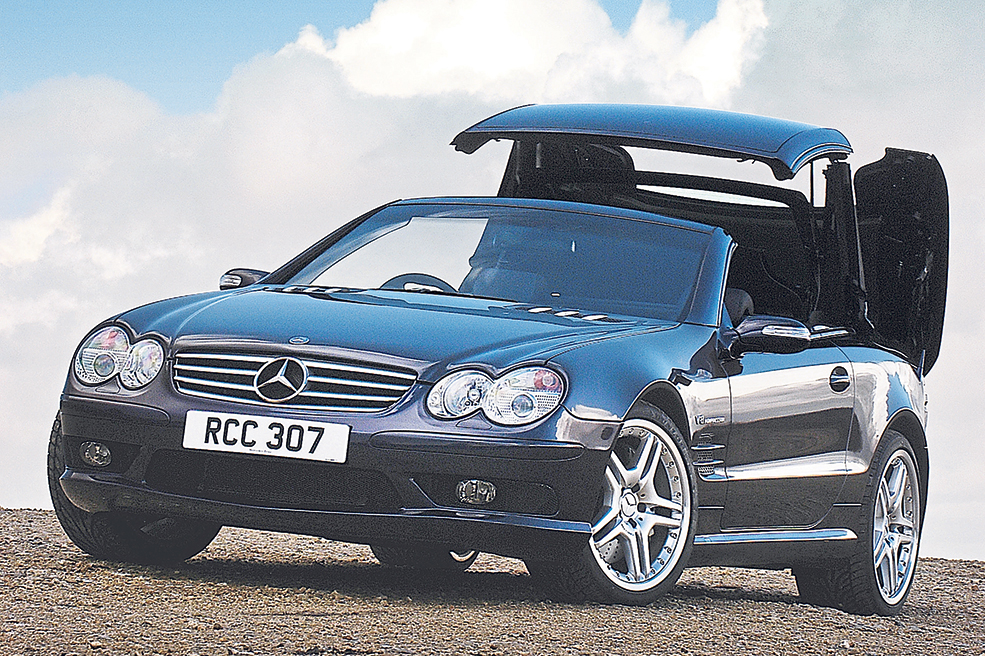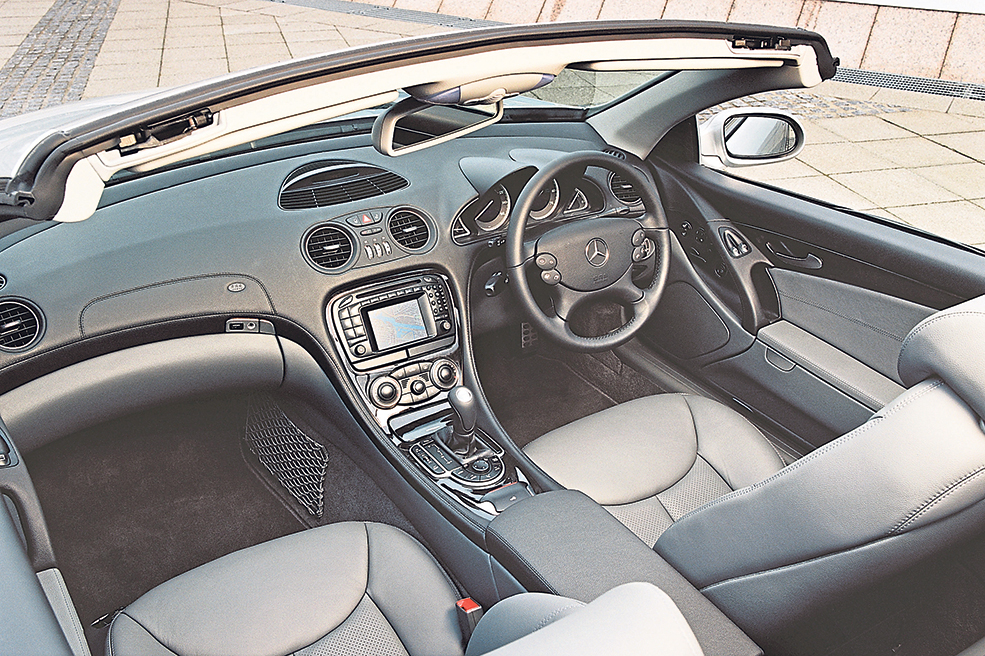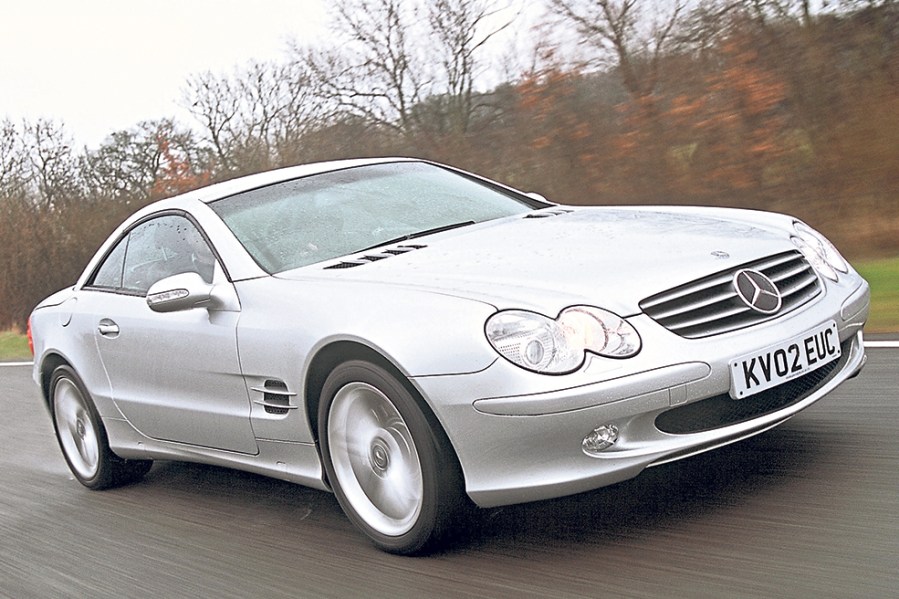The first examples of the famous R230 SL series for the new millennium are now 20 years old. Here’s how to buy a great example of this technological powerhouse
Words: Will Daniels
Conceived in the late 1990s to replace the aging but still popular R129 SL, the ‘Sport-Leicht’ for the 21st century was designed with a 3D super-computer called ‘CAVE’, which projected full-size images via five projectors permitting close inspection of all surfaces digitally – a first for the car industry.
The R230-generation Mercedes SL was launched to an enthusiastic public reception and motoring press alike, who appreciated the bold new design ethos with sweeping, modern lines, new quad headlights (adopted on other models throughout the range), yet retaining the essential link to Mercedes’ past with the side vents on each front wing.
The R230 also featured a first for the SL range: the clever folding metal roof of the same design as pioneered on the R170 SLK, with optional panoramic glass (hugely desirable, but an £8000 option when new), doing away with the traditional fabric soft-top and the awkward removable hard top of old. This gave the R230 much wider appeal and greater all year-round usability, a big deal to many buyers of all demographics across the world.
The SL500 version was also built with ABC – Active Body Control, part of the car’s new adjustable air suspension system, offering various suspension stiffness settings with automatic control and adjustable ride height. The SL350 featured traditional coil springs (although ABC was optional), adaptive cruise control, automatic xenon headlights, COMAND-based in-car entertainment with sat-nav, standard dual-zone digital climate control with AC, keyless go, an on-board computer and electric heated memory seats with optional seat cooling and massage function.
The R230 was available from launch as the SL500, with the proven M113-series (302bhp) 5.0-litre V8, and the SL350 featuring the M112 (242bhp) 3.7-litre V6. In 2003 came the awesome SL55 AMG boasting the epic M113 5.5-litre supercharged V8 that developed a whopping 493bhp and 700Nm of torque, resulting in staggering levels of performance and noise.
There was also the more refined and slightly less ‘shouty’ SL600, which gave the same power as the SL55 but more torque courtesy of its twin-turbo 5.5-litre V12 engine. The SL65 AMG introduced in 2004 offered even more power via its M275 6.0-litre V12, with 604bhp and 1000Nm of torque driving only the rear wheels (as with all) via automatic transmission.
The first-generation R230s date from 2002-2006. The keyless security option on the first-gen cars required a plastic credit card-style key to be carried on your person for it to work, so although technically keyless it was inconvenient and was dropped in 2004. These earlier cars would only change gear with the buttons on the wheel in ‘Manual’ transmission mode rather than in all modes, as found in post-2003 cars. In 2005 came the adoption of DVD-based navigation rather than the irksome CD-based version on the earlier cars – still not great by today’s standards, and a navigation app on your phone will run rings around them all.

In 2006 came a minor facelift, which saw improved performance on both the SL55 AMG and SL600 models. A nice – but rare to find – option also became available on the SL55 AMG called the PO30 Performance Package, which saw the addition of the more aggressive SL65 front bumper, SL65 brakes, retuned suspension (claiming some affiliation to the Nürburgring), a limited-slip differential, grippy Alcantara steering wheel, two-piece 18-inch wheels and easing of the factory speed limiter permitting an official 186mph.
The standard 350 and 500 models also saw engine changes, with the SL350 having a reduction in capacity to 3.5 litres yet an increase in power to 272bhp. Meanwhile he SL500 grew in capacity to 5.5 litres, lifting output to 383bhp and 530Nm of torque and resulting in very notable improvements in performance and response combined with greater cruising efficiency courtesy of the new 7G transmission.
Other updates across the model range saw a 60 per cent improvement in roll stiffness during cornering for the retuned ABC air suspension (where fitted), a new and much-improved 7G seven-speed automatic transmission with Sport mode giving 30 per cent quicker changes and paddles behind the steering wheel for manual changes, softer leather for the interior, new sill covers, an improved COMAND system, removable luggage cover, remote boot opening and speedier folding metal roof retraction.
In 2008 came the ‘second generation’ R230, which saw the biggest cosmetic change during the model’s lifespan, reflecting Mercedes’ new design philosophy with a more aggressive standard front end losing the quad headlamp arrangement in favour of new single-piece headlamp units, a new three-bar grille and two long ‘power domes’ on the bonnet.
An entry level model was introduced, the SL280 (re-named SL300 in 2009) featuring a 228bhp 3.0-litre V6 engine that gave a reputed 30mpg, whilst the SL350’s power was again increased, now to 312bhp (more than the first gen SL500!). The SL55 AMG was replaced by the SL63 AMG: gone was the blown V8, replaced instead by the magnificent naturally-aspirated 6.2-litre M156 V8 developing 518bhp and 630Nm of torque. The SL63 engine was mated to the 7G automatic transmission, but here ditched the usual torque converter in favour of a wet clutch for pulling away and computer-supported double de-clutching.
The final hurrah of the R230 series included the launch of the SL65 AMG Black Series – a more aggressive, harder, leaner version of the already monstrous 6.0-litre twin turbo V12 SL65 AMG model, now with a fixed carbon-fibre roof (reducing weight), wildly flared arches to cover a 10cm wider track at the front and 8.5cm wider track at the rear, beefed-up five-speed automatic and a host of mechanical, aerodynamic and running gear upgrades. Power was a mighty 661bhp and torque was capped at 1000Nm due to transmission limitations. A rare and incredible machine.
It’s now apparent that the R230 tends to suffer the same common ailments, although the SL350 seems to be the model that attracts the fewest gremlins, predominantly due to its lack of air-suspension. Of course, history and general condition are important, as is how the car has been kept and used. Has it been stored inside on a trickle charge, for example? Has it been serviced by a random garage or a mix of main dealer and Mercedes specialists? Read the service history carefully and check for recurring issues that seem not to have been solved; multiple visits to a specialist for the same or similar issues should ring an alarm bell.

Bodywork
The rear wheelarches can blister from corrosion as the rear wing panels are the only ones made of steel – the rest is a mix of aluminium, magnesium, or plastic.
The black trim either side of the rear window on the retractable hard-top can delaminate and fade, which looks unsightly. The rubber seals can perish around the head rail atop the windscreen and the latches need lubricant here to ensure they release properly, too. A sticking or failed roof mechanism can be costly whether it’s an electronic module fault or, woe betide, a mechanical issue, so do check its motion and operation.
With the roof retracted, open the boot and press the button on the right-hand side of the plastic boot trim inside; it should press in and the roof section lift, permitting access to the luggage area; if not, this could be a costly fix and prevents access to the load area below the stowed roof. Boot handles can also stick when not used, as do emergency key lock access holes.
Engine and transmission
The engines are generally good, although they can suffer brake pipe corrosion, air conditioning condenser corrosion and, on the SL55 in particular, failure of the oil cooler pipe that routes behind the engine and is a mammoth job to replace. The V8s are bomb-proof but can suffer gasket failures leading to mixing of oil and water, particularly on the SL50 5.5-litre naturally-aspirated lump.
The SL55 has a supercharger that must be carefully maintained as part of its regular maintenance and has its own coolant plug. Some owners will no doubt have modified these with a re-map or a smaller pulley to increase the boost pressure giving enhanced performance, so do check what’s been done and by whom. Driveshafts can rumble, while gear changes should be smooth and not jerky.

Susupension, steering and brakes
Early cars seem to suffer failures of the ABC system the most, although later cars are by no means immune. Check the operation of the air suspension carefully – it should raise and lower smoothly and quickly, not slowly or jerkily, and should always sit level. The boot must be dry, and all electrical functions work as they should.
The air suspension struts can fail, with the car usually sitting lower on one corner than the other. This is not a cheap fix, with Mercedes dealers wanting anything from £700 to £1500 (plus VAT) for one strut. An independent specialist with Mercedes Star software will charge significantly less. The Star software is essential to bleed the system after removal and refitting of a suspension strut or main valve block (which also fails) or feed pipe (which rot) on the ABC system. The reset of this is known as the ‘Rodeo Dance’ because the car goes up and down like a rodeo bull to bleed and self-level.
Interior, trim and electrics
Another failing of the R230 is the PSE pump, located in the boot under the floor. This unit powers all the pneumatic systems on the car, such as the central locking. Failure here is due to another common issue: the rubber boot seals (which used to cost £1000 from Mercedes) that can let water into the boot causing damp, mould, smells and of course, failure of the PSE control module and the BCM (battery control module) unit that sends charge between the two batteries.
These cars like to be used, and if not used regularly the battery charge will quickly fall; we’d suggest keeping an R230 on a trickle charger. The car will usually start if left for a while but many functions will not work, and you’ll see the message ‘Secondary Consumers Offline’ that refers to the secondary battery which powers most of the peripherals. It means that things like the electric roof, heated seats, central locking and so on will not function until this battery has sufficient charge; this can take up to 20 minutes at idle or a little less if driven to get the charge back up to operating levels. This can also, of course, be a sign of a failed or failing BCM unit, so do check the boot for mould and damp smells.
Bizarrely, the little inverted dome button for the electric mirror adjustment is widely known to break and fall off. As a result, they’re very expensive and always immediately sold from any breaker’s yard.
Interiors generally wear well, although the lighter colour leathers and softer materials of later cars can degrade more than others. Check seat bolsters for undue wear and tear and, again, check behind for damp in the cabin, particularly behind the front seats and inside the cubby boxes behind the seats which contain SAM modules, fuse boards and CD changer.

Mercedes SL (R230): our verdict
A good SL350 will likely tick most boxes for most buyers, particularly the later 7G cars with more power and better economy. The later SL350 offers similar performance to the earlier 5.0-litre V8 with much improved economy whilst doing without the often-troublesome ABC air suspension.
If you must have a 500, the later 7G cars offer more poke and improved economy over the earlier ones, plus improvements to the air suspension; don’t expect much better than 18-25mpg, but at least you do get a V8 sound.
For sheer performance and drama, the AMG offerings in both SL55 and SL63 form offer a huge grin and ‘wow’ factor but running costs will be higher; the SL55 often does just 9mpg around town and the SL63 is only marginally better.
Regardless of which you choose, the R230 is a refined and multi-talented modern classic – you don’t necessarily need a thumping engine to enjoy its charm.
Mercedes SL (R230) timeline
1996
Work begins on development of a replacement for the R129 SL
2001
R230 SL revealed at the Frankfurt Motor Show in September
R230 appears as the official Formula One Safety Car for the first time at the German Grand PriX
Production begins in October at Mercedes’ Bremen factory. Range includes SL350 and SL500
2003
SL600 and SL55 AMG models arrive
2004
SL65 AMG introduced
2006
Facelifted version of the R230 revealed at the Geneva Motor Show with new engines, improved Active Body Control and a new seven-speed gearbox. Minor exterior changes also included
2008
More thorough facelift introduced at Geneva with new-look front end
SL65 AMG Black Series introduced
2013
R231 SL arrives as R230 replacement
























